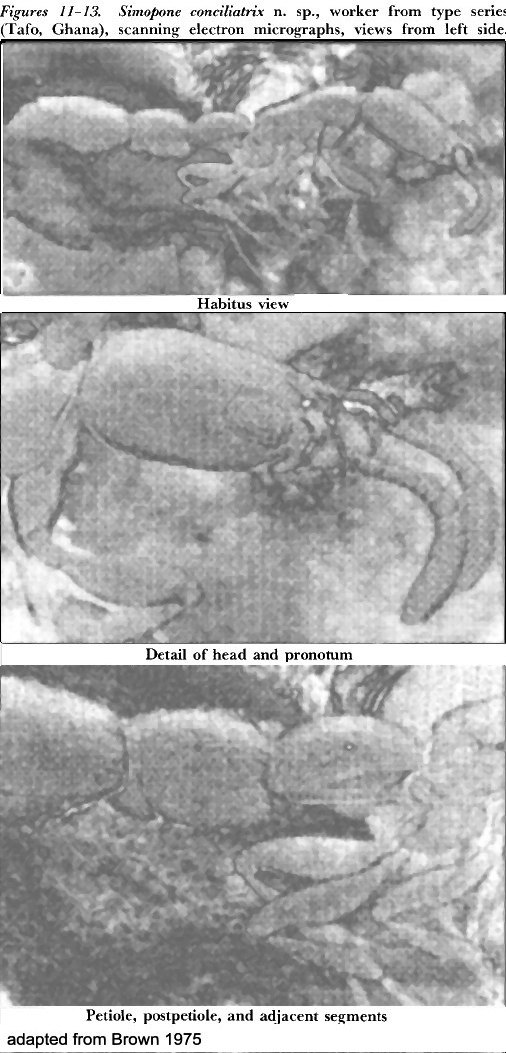Vicinopone conciliatrix (Brown)
 Main Cerapachyinae page Main Cerapachyinae page
 Type location Ghana (Simopone conciliatrix new species,
Brown,
1975: 79, illustrated, adapted right, worker & queen; new genus
placement Bolton & Fisher, 2012: 74); known from
workers and wingless queens; with 12-segmented antennae Type location Ghana (Simopone conciliatrix new species,
Brown,
1975: 79, illustrated, adapted right, worker & queen; new genus
placement Bolton & Fisher, 2012: 74); known from
workers and wingless queens; with 12-segmented antennae  . .
|
 Brown's description (1975) was - Brown's description (1975) was -
WORKER - TL 2.4-3.4 mm, HW 0.53-0.68, HW 0.33-0.42, SL 0.18-0.29 (Ghana
specimens)
Head in full face view strongly elongate, with parallel but distinctly
convex sides, subrectangular posterior angles and a finely marginate
feebly concave posterior border. Eyes large broad elliptical and weakly
convex, situated anteriorly. Antennae 12-segmented; funiculus apically
incrassate; funiculus segments 2-9 longer than broad, apical segment
more than twice as long as subapical, last four segments forming a
faint club. No ocelli. Alitrunk almost three times as long as broad;
only feebly constricted in the middle; declivity of propodeum with a
distinct raised semicircular margin. Petiole barrel-shaped, convex
laterally and vertically, with a fine dorsolateral margin; subpetiolar
process low with a pointed anterior convexity and a tapered posterior
part. Pygidium with an impressed, nearly flat disc, bordered laterally
with a continuous U-shaped margin with 20+ minute denticles and a stout
sting from the true apex.
Body slender, more or less cylindrical, including appendages; colour
yellow, smooth and shining with scattered piligerous punctures, except
for limited faintly longitudinal striolate-puncturation on centre and
sides of head, along lower sides of alitrunk and lower sides of
petiole; space between frontal carinae finely roughened. Pilosity
sparse, short, fine and decumbent to suberect, except for an erect hair
on each humerus; longer such hairs on the petiole, postpetiole and
gaster. Scapes and legs with fine pilosity, funiculi with many short
hairs, except apical segment which has dense fine micropubescence.
Collected by B Bolton, holotype plus 120 other workers and two dealate
queens and larvae, from a nest about 2 meters above ground in a hollow
twig on a cocoa tree, in moderate shade, at Tafo (CRIG) in Ghana, 27
November 1970. Brown also saw two workers from the Yangambi Reserve,
nesting in hollow twigs, Yangambi, Zaïre (A Raignier & J
van Boven, 6 October 1949). Named conciliatrix as it
conciliated a mixture of characters of Lioponera (=Phyracaces),
Simopone and Cerapachys
|